Six weeks before I embarked on a research mission in Kyoto, I was sitting alone at a bar counter in Melbourne. Next to me, a woman was bragging loudly to a friend: She, too, was heading to Kyoto, I quickly discerned. Except her trip was in four months. And she’d just pulled an all-nighter booking restaurant reservations.
As I snooped on the conversation, I broke out in a sweat, panicking because I’d yet to secure a single table. Then I remembered: Eating well in Japan is absolutely not something to lose sleep over.
It’s true that the best-known institutions book up faster than Taylor Swift’s Eras tour and that casual noodle joints have lines longer than a Disney ride’s. But zoom out and you’ll see that those spots are mobbed because they’ve been repeatedly glorified by a handful of overly influential TikTok personalities and the jury of the World’s 50 Best Restaurants awards. There’s usually good reason for the accolades, but there are tons of other places that are just as good — if not better.
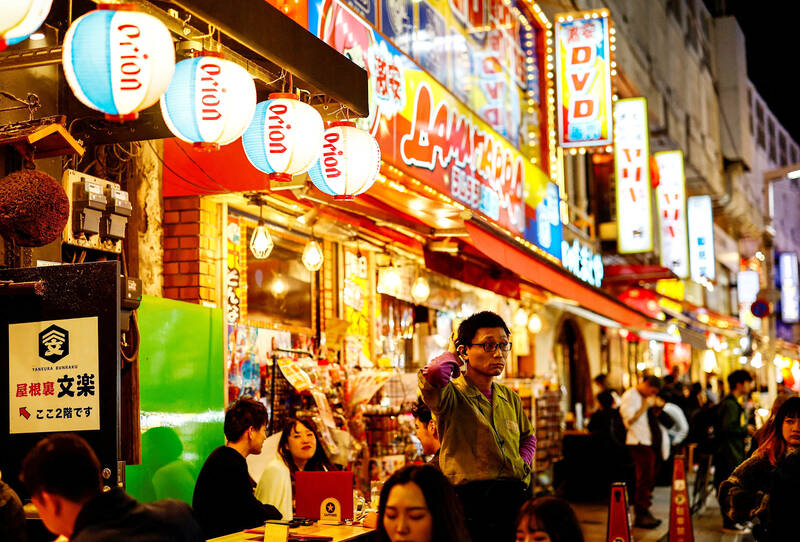
Photo: Reuters
So if you’re planning a trip to Japan, here’s a crash course to dining phenomenally — without any of the stress. At the end of the day, that’s the thing most worth bragging about.
KNOWING WHERE TO GO
There are three golden rules to whittling down your list of must-try meals. First up: Use Tabelog, not Google, to find untouristed gems. While Google is easier to scan for Western travelers, its reviews are a meaningless mosh pit of mixed cultural inclinations; Japanese praise usually hovers at three stars while hyperbolic Americans go for five stars or one. Because Tabelog is primarily for the local audience, a four-star rating signals exceptional cuisine. (Keep in mind that the Japanese palate tends to be more subtle and fish-forward than that of a Westerner.)
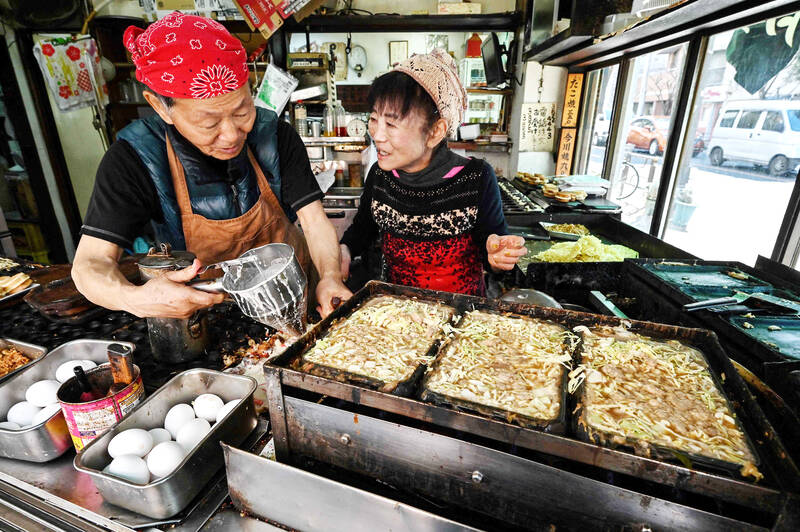
Photo: AFP
Second, avoid kaiseki fatigue. Many foodies have their sights set on these hyperseasonal, multicourse meals that are executed with the precision of a culinary ballet. But if you’re staying in a ryokan-style hotel during your trip, this kind of ceremonious menu will be part of the experience. There’s no need to repeat this over and over, especially when great Japanese dining can come in so many other delicious forms, be it teppanyaki, shojin ryori, or shabu shabu. (Remember, save sushi for coastal cities!)
Third: Don’t take it personally. Some establishments can seem quite rude in the way they decline foreign guests. It’s because proprietors are keen to engage with their clientele, tell jokes and nurture relationships with regulars, and the language barrier can be inhibiting. (Funnily enough, some “no foreigner” signs in front of a restaurant window have an added line in Japanese that says, ?“If you can read this, please enter.”) If your English earns you a cold shoulder, a little Japanese will go a long way; even just an oishi desu (“this is delicious”) can work wonders.
SNAGGING RESERVATIONS

Photo: Reuters
If you have your heart set on a particular place, the conventional wisdom is true: You should book as early as possible. If this is the most important aspect of your holiday, nab your table before sorting out plane tickets.
If you can pack some flexibility, though, the best strategy is to sort out hotels first. That way, you can try leveraging your hotel’s concierge rather than relying on Web sites like My Concierge Japan or Tableall, which charge hefty fees to secure top tables. Concierges can call establishments directly and advocate for your needs, like wanting to sit directly at the sushi counter — but you may be asked to sign a contract saying that you’ll be a respectful and dutiful patron (more on that later).
Don’t let that rub you the wrong way. When guests show up late or act disrespectfully, “that puts our relationships — and reputation — at risk,” explains Hana Tsukamoto, co-founder of the luxe Kyoto-based hospitality brand Maana, who recently stopped offering reservations assistance for the most sought-after spots, because it had turned into such a liability.
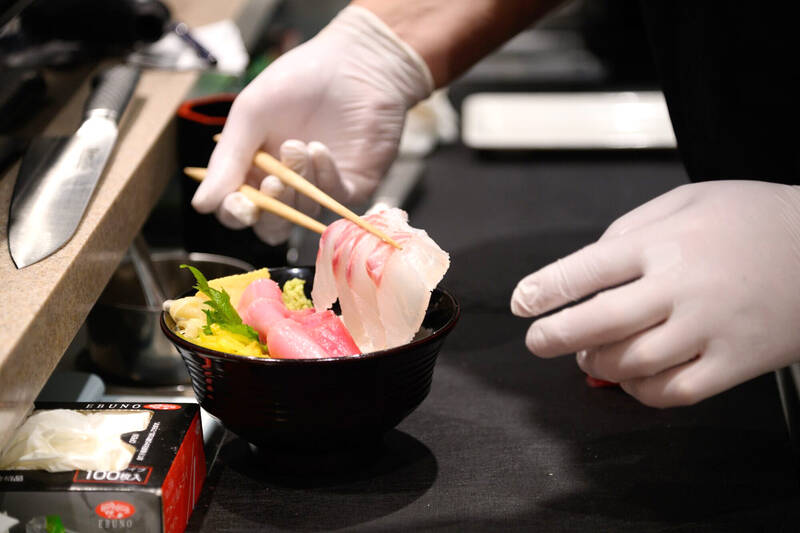
Photo: Bloomberg
Asking Japanese friends to place a few reservation calls is of course the best option, but hiring a guide is a worthy substitute if you’re lacking local contacts. Opt for foreigners who have lived in Japan for years and speak fluent Japanese — they’re better at bridging the culture gap than natives. Connect with them before your arrival with a request for a reservation or two, or let your guide take the wheel and do some culinary wayfinding while you’re together — in two hours with Audley Travel’s Kyoto-based Duncan Flett, I discovered a handful of spots that I never would have found on my own.
AVOID THE RAMEN TRAP!
Anyone who tells you that it’s worth it to wait two hours for a specific bowl of ramen is missing the point entirely. These noodle shops are meant to be pit stops for a swift slurp. And anyway, eating ramen as a foreigner is like watching Olympic figure skating — can you really tell the difference between a performance that earns a 9.8 instead a 9.9? I promise you can’t.
Which is all to say: Please don’t be the 281st person in line at the ultrafamous Honke Daiichi Asahi Honten in Kyoto or Chukasoba Ginza Hachigou in Tokyo. No bowl of ramen is worth giving up an afternoon exploring a new city.
Instead, take a chance on a spot not prominently featured on some food TikTok. My favorite line-free bowls of ramen on my most recent trip to Kyoto were at Torisoba223 and 66Tantan — and I always go for the chicken, since you can easily get great pork ramen in any major city around the world these days.
ABOUT THOSE CONVENIENCE STORES
I love a convenience store, or konbini as they’re called in Japan, as much as any foreigner. (Trust me, I can eat Lawson’s delicious and cheap egg salad sandwiches all day.) But with the yen at an all-time low, now is not the time to make 7-Eleven your entire trip’s obsession. If you want to visit these spots, go to shop rather than to eat; the branded gear and apparel at Family Mart, for example, includes great pencils and stationery. I’m also partial to their line of high-quality everyday pieces called “Convenience Wear” that handily beats the basics at Uniqlo.
If quick, authentic and price-sensitive eats are something you want to prioritize, try something like Kyoto’s obanzai instead. These homestyle cooking spots typically have set menus at astonishingly low prices; a meal including tempura and sashimi at Kokora-ya, for example, will only set you back US$6. Yes, you read that correctly.
SOME BEHAVIORAL BASICS
In Japan, the customer is not always right. Here, the social contract goes both ways. Just as diners expect restaurant owners to be gracious hosts, they too expect customers to act with a certain amount of decorum. Punctuality is key — lateness is simply not tolerated in Japanese society. (Case in point: If you’re on a delayed commuter train, you’ll likely be handed a special ticket for clemency from your boss.) Loud talking and flagrant selfie-taking are major faux pas; tipping is also considered impolite and can be perceived as an unsolicited handout to someone who takes great pride in their work.
QUALITY CONTROL WE TRUST
Here’s the one thing to remember above all else: The standard of culinary quality in Japan far outshines most destinations worldwide, and the likelihood of disappointment is low. With that in mind, take a chance! Go for something completely unknown. If you couldn’t get the coveted reservation to that buzzy, Michelin-starred spot — or the line for the hippest ramen shack is impossibly long — it’s really OK! Leave room for serendipity. The thrill of stumbling into a bona fide gem is easy to come by in Japan, you just have to unclench and unsubscribe to let it happen.
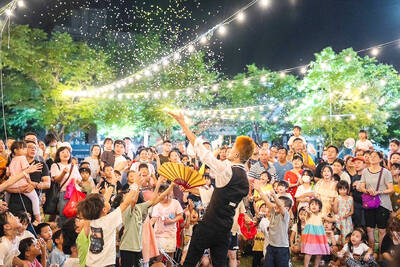
The depressing numbers continue to pile up, like casualty lists after a lost battle. This week, after the government announced the 19th straight month of population decline, the Ministry of the Interior said that Taiwan is expected to lose 6.67 million workers in two waves of retirement over the next 15 years. According to the Ministry of Labor (MOL), Taiwan has a workforce of 11.6 million (as of July). The over-15 population was 20.244 million last year. EARLY RETIREMENT Early retirement is going to make these waves a tsunami. According to the Directorate General of Budget Accounting and Statistics (DGBAS), the

Last week the story of the giant illegal crater dug in Kaohsiung’s Meinong District (美濃) emerged into the public consciousness. The site was used for sand and gravel extraction, and then filled with construction waste. Locals referred to it sardonically as the “Meinong Grand Canyon,” according to media reports, because it was 2 hectares in length and 10 meters deep. The land involved included both state-owned and local farm land. Local media said that the site had generated NT$300 million in profits, against fines of a few million and the loss of some excavators. OFFICIAL CORRUPTION? The site had been seized
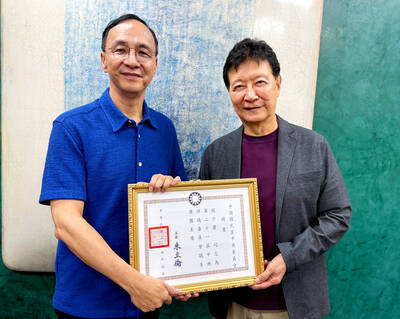
Next week, candidates will officially register to run for chair of the Chinese Nationalist Party (KMT). By the end of Friday, we will know who has registered for the Oct. 18 election. The number of declared candidates has been fluctuating daily. Some candidates registering may be disqualified, so the final list may be in flux for weeks. The list of likely candidates ranges from deep blue to deeper blue to deepest blue, bordering on red (pro-Chinese Communist Party, CCP). Unless current Chairman Eric Chu (朱立倫) can be convinced to run for re-election, the party looks likely to shift towards more hardline
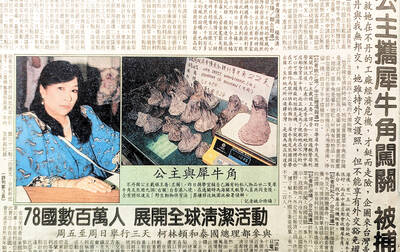
Sept. 15 to Sept. 21 A Bhutanese princess caught at Taoyuan Airport with 22 rhino horns — worth about NT$31 million today — might have been just another curious front-page story. But the Sept. 17, 1993 incident came at a sensitive moment. Taiwan, dubbed “Die-wan” by the British conservationist group Environmental Investigation Agency (EIA), was under international fire for being a major hub for rhino horn. Just 10 days earlier, US secretary of the interior Bruce Babbitt had recommended sanctions against Taiwan for its “failure to end its participation in rhinoceros horn trade.” Even though Taiwan had restricted imports since 1985 and enacted